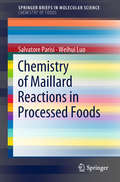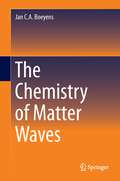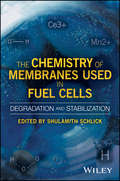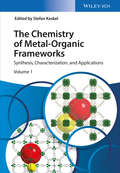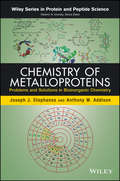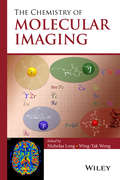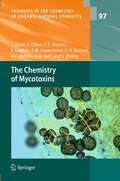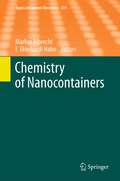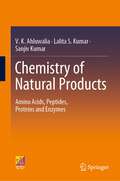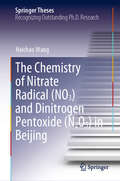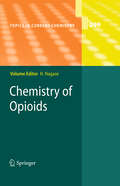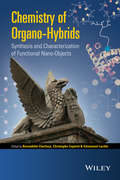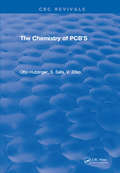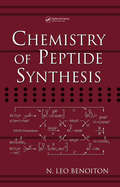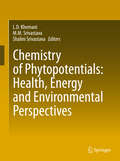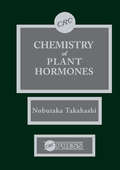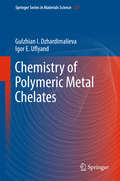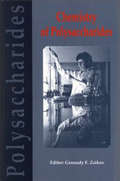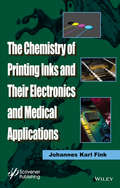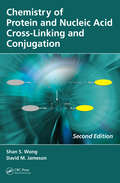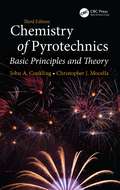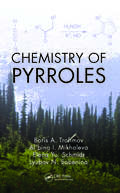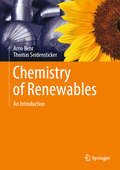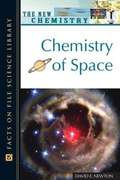- Table View
- List View
Chemistry of Maillard Reactions in Processed Foods (Springerbriefs In Molecular Science)
by Salvatore Parisi Weihui LuoThis SpringerBrief explains the importance of Maillard reactions in food processing. It underlines that the term “Maillard reaction” actually does not describe one single chemical reaction, but an entire class of chemical reactions, which lead to browning, with a strong impact on visual appearance, odor, and flavor. It emphasizes that the Maillard reactions are still not fully characterized, despite extensive historical studies. While under the right conditions Maillard reactions have many favorable effects (e.g. formation of antioxidants), the Brief discusses that there are also conditions where Maillard reactions can result in toxic or mutagenic reactions. Hence, it emphasizes that the reaction should be viewed as a complex network of various sub-reactions, with a plethora of concomitant reaction mechanisms and kinetics. This Brief thus makes a step toward a holistic evaluation of the complexity of the Maillard reaction scheme, with the aim of making better and more targeted use in food processing.
Chemistry of Matter (Prentice Hall Science Integrated Learning System)
by Prentice-Hall StaffChemistry of Matter, Volume 1
The Chemistry of Matter Waves
by Jan C. A. BoeyensThe quantum and relativity theories of physics are considered to underpin all of science in an absolute sense. This monograph argues against this proposition primarily on the basis of the two theories' incompatibility and of some untenable philosophical implications of the quantum model. Elementary matter is assumed in both theories to occur as zero-dimensional point particles. In relativity theory this requires the space-like region of the underlying Minkowski space-time to be rejected as unphysical, despite its precise mathematical characterization. In quantum theory it leads to an incomprehensible interpretation of the wave nature of matter in terms of a probability function and the equally obscure concept of wave-particle duality. The most worrisome aspect about quantum mechanics as a theory of chemistry is its total inability, despite unsubstantiated claims to the contrary, to account for the fundamental concepts of electron spin, molecular structure, and the periodic table of the elements. A remedy of all these defects by reformulation of both theories as nonlinear wave models in four-dimensional space-time is described.
The Chemistry of Membranes Used in Fuel Cells: Degradation and Stabilization
by Shulamith SchlickExamines the important topic of fuel cell science by way of combining membrane design, chemical degradation mechanisms, and stabilization strategies This book describes the mechanism of membrane degradation and stabilization, as well as the search for stable membranes that can be used in alkaline fuel cells. Arranged in ten chapters, the book presents detailed studies that can help readers understand the attack and degradation mechanisms of polymer membranes and mitigation strategies. Coverage starts from fundamentals and moves to different fuel cell membrane types and methods to profile and analyze them. The Chemistry of Membranes Used in Fuel Cells: Degradation and Stabilization features chapters on: Fuel Cell Fundamentals: The Evolution of Fuel Cells and their Components; Degradation Mechanism of Perfluorinated Membranes; Ranking the Stability of Perfluorinated Membranes Used in Fuel Cells to Attack by Hydroxyl Radicals; Stabilization Mechanism of Perfluorinated Membranes by Ce(III) and Mn(II); Hydrocarbon Proton Exchange Membranes; Stabilization of Perfluorinated Membranes Using Nanoparticle Additives; Degradation Mechanism in Aquivion Perfluorinated Membranes and Stabilization Strategies; Anion Exchange Membrane Fuel Cells: Synthesis and Stability; In-depth Profiling of Degradation Processes in Nafion Due to Pt Dissolution and Migration into the Membrane; and Quantum Mechanical Calculations of the Degradation Mechanism in Perfluorinated Membranes. Brings together aspects of membrane design, chemical degradation mechanisms and stabilization strategies Emphasizes chemistry of fuel cells, which is underemphasized in other books Includes discussion of fuel cell performance and behavior, analytical profiling methods, and quantum mechanical calculations The Chemistry of Membranes Used in Fuel Cells is an ideal book for polymer scientists, chemists, chemical engineers, electrochemists, material scientists, energy and electrical engineers, and physicists. It is also important for grad students studying advanced polymers and applications.
The Chemistry of Metal-Organic Frameworks: Synthesis, Characterization, and Applications
by Stefan KaskelProviding vital knowledge on the design and synthesis of specific metal-organic framework (MOF) classes as well as their properties, this ready reference summarizes the state of the art in chemistry. Divided into four parts, the first begins with a basic introduction to typical cluster units or coordination geometries and provides examples of recent and advanced MOF structures and applications typical for the respective class. Part II covers recent progress in linker chemistries, while special MOF classes and morphology design are described in Part III. The fourth part deals with advanced characterization techniques, such as NMR, in situ studies, and modelling. A final unique feature is the inclusion of data sheets of commercially available MOFs in the appendix, enabling experts and newcomers to the field to select the appropriate MOF for a desired application. A must-have reference for chemists, materials scientists, and engineers in academia and industry working in the field of catalysis, gas and water purification, energy storage, separation, and sensors.
Chemistry of Metalloproteins
by Joseph J. Stephanos Anthony W. Addisonith a list of suggested original research articles and reviews for further investigation of individual topics. Presenting our most current understanding of metalloproteins, Chemistry of Metalloproteins is recommended for students and researchers in coordination chemistry, biology, and medicine. Each volume of the Wiley Series in Protein and Peptide Science addresses a specific facet of the field, reviewing the latest findings and presenting a broad range of perspectives. The volumes in this series constitute essential reading for biochemists, biophysicists, molecular biologists, geneticists, cell biologists, and physiologists as well as researchers in drug design and development, proteomics, and molecular medicine with an interest in proteins and peptides.
The Chemistry of Molecular Imaging
by Wing-Tak Wong Nicholas LongCovering all the fundamentals of modern imaging methodologies, including their techniques and application within medicine and industry, The Chemistry of Molecular Engineering focuses primarily on the chemistry of probes and imaging agents, as well as chemical methodology for labelling and bioconjugation. Written by an interdisciplinary team of experts, this book investigates the chemistry of molecular imaging and helps to educate non-chemists already involved in the area of molecular imaging. It addresses all the major modalities and techniques, such as MRI, positron emission tomography, single photon emission computed tomography, ultrasound, and fluorescence/optical imaging.
The Chemistry of Mycotoxins
by Anna M. Linsenmeier Stephanie Lindner Bettina M. Ruff Sabilla Zhong Franziska Gläser Carsten Kramer Anne C. Meister Kye-Simeon Masters Stefan BräseThe biological activity of mycotoxins ranges from weak and/or sometimes positive effects, such as antibacterial activity (see penicillin derivatives derived from Penicillium strains) to strong mutagenic (e. g. aflatoxins, patulin), carcinogenic (e. g. aflatoxins), teratogenic, neurotoxic (e. g. ochratoxins), nephrotoxic (e. g. fumonisins, citrinin), hepatotoxic, and immunotoxic (e. g. ochratoxins, diketopiperazines) activity. Nowadays, many laboratories around the world are specialized in the detection of mycotoxins in food products and contaminated material found in housing. In this volume, a focus on the most important classes of mycotoxins is provided and their chemistry of the last ten years is discussed. In each Section, the individual biological impact is outlined. Sections are arranged according to mycotoxin classes (e. g. aflatoxins) and/or structural classes (e. g. resorcinyl lactones, diketopiperazines). The biology of mycotoxins is also described.
Chemistry of Nanocontainers (Topics in Current Chemistry #319)
by Markus Albrecht F. Ekkehardt HahnMolecular Cages and Capsules with Functionalized Inner Surfaces, by Stefan Kubik. Drug Delivery by Water-Soluble Organ metallic Cages, by Bruno Therrien. Reversibly Expanded Encapsulation Complexes, by Dariush Ajami und Julius Rebek. Container Molecules Based on Imine Type Ligands, by A. Carina Schulze und Iris M. Oppel. Molecular Capsules Derived from Resorcin[4]arenes by Metal-Coordination, by Tobias Schröder, Satya Narayan Sahu und Jochen Mattay. Coronates, Spherical Containers, Bowl-Shaped Surfaces, Porous 1D-, 2D-, 3D-Metallo-Coordination Polymers, and Metallodendrimers, by Rolf W. Saalfrank und Andreas Scheurer.
Chemistry of Natural Products: Amino Acids, Peptides, Proteins and Enzymes
by V.K. Ahluwalia Lalita S. Kumar Sanjiv KumarThis book is designed to serve as a textbook for core as well as elective courses offered to undergraduate and advanced undergraduate students enrolled in chemistry. This textbook comprehensively deals various topics of organic chemistry such as amino acids, peptides, proteins and enzymes. The text is divided into four chapters: a chapter each dedicated to amino acids, peptides, proteins and enzymes, respectively. The important reactions have been explained with the help of the mechanisms involved. It gives a detailed account of the solution phase and solid phase synthesis of peptides as well as discussing the structure and function of some biologically important peptides. It also covers the classification, nomenclature and mode of action of enzymes, and a detailed account of the structure and function of different co-enzymes. The book also includes pedagogical features like end-of-chapter exercises to aid in self learning. Given the scope, this textbook will be useful for graduate and advanced graduate students pursuing the course of chemistry, especially organic chemistry.
The Chemistry of Nitrate Radical (Springer Theses)
by Haichao WangThis book systematically describes the instrument setup for the measurement of nitrate radical (NO3) and dinitrogen pentoxide (N2O5), as well as the mixing ratio, chemical behaviors, and atmospheric impacts of NO3 and N2O5 in Beijing, China. It also discusses the instrument design and data analysis method in detail. Based on several field measurements of NO3 and N2O5 in Beijing, it shows the variation in concentration and the budget of NO3 and N2O5. The N2O5 heterogeneous uptake coefficient was determined using various methods, and the relationship between the N2O5 uptake coefficient and the particle properties was demonstrated, as well as the impact of NO3–N2O5 chemistry to the atmospheric oxidation and the formation of particulate nitrate. These results increase our understanding of nighttime chemistry and provide insights into the role of NO3–N2O5 chemistry in other polluted regions.
Chemistry of Opioids (Topics in Current Chemistry #299)
by Hiroshi NagaseRecent Advances in the Synthesis of Morphine and Related Alkaloids; by N. Chida * Opioids in Preclinical and Clinical Trials; by H. Nagase and H. Fujii * Synthesis of 14-Alkoxymorphinan Derivatives and Their Pharmacological Actions; by H. Schmidhammer and M. Spetea * 14-Amino-4,5-Epoxymorphinan Derivatives and Their Pharmacological Actions; by J. W. Lewis and S. M. Husbands * Nonpeptidic Delta (δ) Opioid Agonists and Antagonists of the Diarylmethylpiperazine Class: What Have We Learned?; by S. N. Calderon * Synthesis of Neoclerodane Diterpenes and Their Pharmacological Effects; by K. M. Lovell, K. M. Prevatt-Smith, A. Lozama and T. E. Prisinzano * Synthesis of Novel Basic Skeletons Derived from Naltrexone; by H. Nagase and H. Fujii * Twin and Triplet Drugs in Opioid Research; by H. Fujii * 3D-Pharmacophore Identification for κ-Opioid Agonists Using Ligand-Based Drug-Design Techniques; by N. Yamaotsu and S. Hirono
Chemistry of Organo-hybrids
by Christophe Coperet Bernadette Charleux Emmanuel LacoteThis book provides readers with a one-stop entry into thechemistry of varied hybrids and applications, from a molecularsynthetic standpoint* Describes introduction and effect of organicstructures on specific support components (carbon-based materials,proteins, metals, and polymers).* Chapters cover hot topics including nanodiamonds,nanocrystals, metal-organic frameworks, peptide bioconjugates, andchemoselective protein modification* Describes analytical techniques, with pros and cons,to validate synthetic strategies* Edited by internationally-recognized chemists fromdifferent backgrounds (synthetic polymer chemistry, inorganicsurfaces and particles, and synthetic organic chemistry) to pulltogether diverse perspectives and approaches
The Chemistry of PCB'S
by Otto HutzingerThe literature on chlorinated biphenyl is growing rapidly. Review articles on PCB's cited in this book usually contained a section on the toxicity of PCB. The structure and nomenclature are detailed. The chapters and topics included are (1) commercial PCB preparations: properties and compositions, (2) synthesis of chlorobiphenyls, (3) chemical reactions of chlorobiphenyls, (4) photodegradation of chlorobiphenyls, (5) metabolism of chlorobiphenyls, (5) mass spectroscopy of chlorobiphenyls, (6) nuclear magnetic resonance of chlorobiphenyls, (7) ultraviolet spectroscopy of chlorobiphenyls, (8) infrared spectrometry of chlorobiphenyls, (9) determination of chlorobiphenyls, and (10) recent developments.
Chemistry of Peptide Synthesis
by N. Leo BenoitonChemistry of Peptide Synthesis is a complete overview of how peptides are synthesized and what techniques are likely to generate the most desirable reactions. Incorporating elements from the author's role of Career Investigator of the Medical Research Council of Canada and his extensive teaching career, the book emphasizes learning rather th
Chemistry of Phytopotentials: Health, Energy And Environmental Perspectives
by Shalini Srivastava Ld Khemani Mm SrivastavaSince the beginning of human civilization, plants have been our true companions. Plants contribute not only to our existence but also serve us through discovery, design and the treatment of various diseases where there is no satisfactory cure in modern medicine. This has focused Natural Product Chemists to unravel plants therapeutic potential in the light of modern analytical and pharmacological understandings. Presence of multiple active phytochemicals in medicinal plants offers exciting opportunity for the development of novel therapeutics, providing scientific justification for their use in traditional medicines. Non-food plants have been recognized as biofactories for the production of eco-friendly value added materials including agricultural, food products, enzymes, nutraceuticals etc. They have also been widely explored for personal care, industrial products and sources of energy generation. The proven efficacy of botanicals has been appreciated by the scientific community and strengthened plant-human relationship. The synergism in the Phytoproducts, the result of the interaction of two or more moieties, is not simply additive but multiplicative. Recent acceptance of the Food and Drug Administration (US) for herbal-medicine based preparation has renewed interest in Natural Product Research. The year 2011 is declared as the International Year of Chemistry (IYC 2011) by the United Nations Assembly. On this occasion, the present conference CPHEE 2011 aims to offer chemists from diverse areas to come to a common platform to share the knowledge and unveil the chemistry and magic potentials of phytoproducts for the mankind.
Chemistry of Plant Hormones
by Nobutaka TakahashiThe chemistry of the five principal plant hormone groups is discussed in detail in this volume. Contributing authors review history and occurrence of each hormone group, methods of isolation and detection, biosynthesis and metabolism, and structural determination. Through these analyses, the authors clarify the role of endogenous plant growth regulators in the life cycle of higher plants. The text is supplemented with over 350 figures and structures of various plant hormones.
Chemistry of Polymeric Metal Chelates
by Gulzhian I. Dzhardimalieva Igor E. UflyandThis book deals with the chemistry of polymeric metal chelates. The main results and the production and chemical structure of polymers with chelate units as well as the specificity of metal complex binding of different structure are presented here. This book also reveals the transformations which components undergo in the course of chelation. Special attention is paid not only to synthetic but also to natural (including living) systems. The usage of polymeric metal chelates and their development are examined. The related research was performed for chelates with chain structure. This book is useful to researchers being active in synthesis and design of macromolecular metal chelates
Chemistry of Polysaccharides
by Gennady E. ZaikovThis monograph summarizes scientific achievements in the field of polysaccharide chemistry performed in the last decade. The book is intended for wide range of readers: students, post graduates, engineers and scientists engaged in polymer chemistry, organic and physical chemistry.
The Chemistry of Printing Inks and Their Electronics and Medical Applications
by Johannes Karl FinkThis book focuses on the chemistry of inkjet printing inks, as well to special applications of these materials. As is well-documented, this issue has literallyexploded in the literature in particular in the patent literature.After an introductory section to the general aspects of the field, the types and uses of inkjet printing inks are summarized followed by an overview on the testing methods. Special compounds used as additives dyes, and pigments in inkjet printing inks are documented.The applications to the medical field - drug delivery systems, tissue engineering, bioprinting in particular - are detailed. The applications in the electronics industry are also documented such as flexible electronics, integrated circuits, liquid crystal displays, along a description of their special inks.The book incorporates many structures of the organic compounds used for inkjet printing inks as they may not be familiar to the polymer and organic chemists.
Chemistry of Protein and Nucleic Acid Cross-Linking and Conjugation
by Shan S. Wong David M. JamesonSince the publication of the first edition of Chemistry of Protein Conjugation and Cross-Linking in 1991, new cross-linking reagents, notably multifunctional cross-linkers, have been developed and synthesized. The completion of the human genome project has opened a new area for studying nucleic acid and protein interactions using nucleic acid cross
Chemistry of Pyrotechnics: Basic Principles and Theory, Third Edition
by Chris Mocella John A. ConklingThis book provides chemists with technical insight on pyrotechnics and explosives. It emphasizes basic chemical principles and practical, hands-on knowledge in the preparation of energetic materials. It examines the interactions between and adaptations of pyrotechnics to changing technology in areas such as obscuration science and low-signature flame emission. The updated third edition discusses chemical and pyrotechnic principles, components of high-energy materials, elements of ignition, propagation, and sensitivity. It offers heat compositions, including ignition mixes, delays, thermites, and propellants and investigates the production of smoke and sound as well as light and color.
Chemistry of Pyrroles
by Boris A. Trofimov Al'bina I. Mikhaleva Elena Yu Schmidt Lyubov N. SobeninaDuring the last 30 years, knowledge of the essential role that pyrrole structures play in the chemistry of living organisms, drug design, and the development of advanced materials has increased. Correspondingly, research on the diverse issues of synthetic, theoretical, and applied chemistry has snowballed. Devoted to the latest achievements of this
Chemistry of Renewables: An Introduction
by Arno Behr Thomas SeidenstickerThis textbook introduces the industrial production and processing of natural resources. It is divided into six major topics (fats and oils, carbohydrates, lignin, terpenoids, other natural products, biorefinery), which are divided into a total of 20 chapters.Each chapter is self-contained and therefore a compact learning unit, which can be worked on by students in self-study or presented by lecturers. Clear illustrations, flow diagrams, apparatus drawings and photos facilitate the understanding of the subject matter. All chapters end with a succinct summary, the "Take Home Messages". Each chapter is supplemented by ten short test questions, which can be solved quickly after working through the chapter; the answers are at the end of the book. All chapters contain bibliographical references that focus on essential textbooks and reference works. As a prior knowledge, only basic knowledge of chemistry is required.
Chemistry of Space
by David E. NewtonChemistry of Space provides an overview of the latest information about the solar system, comets, and meteors, and other features of the universe made available as a result of space exploration and research in astrochemistry. The volume is an impressive account of our universe, the events through which it was created, the changes that have taken place during its evolution, and its present composition.
